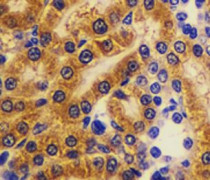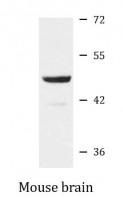ARG55927
anti-SHC1 antibody
anti-SHC1 antibody for ICC/IF,IHC-Formalin-fixed paraffin-embedded sections,Western blot and Human,Mouse,Rat
Overview
| Product Description | Rabbit Polyclonal antibody recognizes SHC1 |
|---|---|
| Tested Reactivity | Hu, Ms, Rat |
| Tested Application | ICC/IF, IHC-P, WB |
| Host | Rabbit |
| Clonality | Polyclonal |
| Isotype | IgG |
| Target Name | SHC1 |
| Antigen Species | Human |
| Immunogen | Synthetic peptide of Human SHC1 |
| Conjugation | Un-conjugated |
| Alternate Names | SH2 domain protein C1; SHC-transforming protein 3; SHC-transforming protein 1; SHC; Src homology 2 domain-containing-transforming protein C1; SHC-transforming protein A; SHCA |
Application Instructions
| Application Suggestion |
|
||||||||
|---|---|---|---|---|---|---|---|---|---|
| Application Note | * The dilutions indicate recommended starting dilutions and the optimal dilutions or concentrations should be determined by the scientist. | ||||||||
| Positive Control | Mouse brain |
Properties
| Form | Liquid |
|---|---|
| Purification | Affinity purification with immunogen. |
| Buffer | PBS (pH 7.3), 0.02% Sodium azide and 50% Glycerol. |
| Preservative | 0.02% Sodium azide |
| Stabilizer | 50% Glycerol |
| Storage Instruction | For continuous use, store undiluted antibody at 2-8°C for up to a week. For long-term storage, aliquot and store at -20°C. Storage in frost free freezers is not recommended. Avoid repeated freeze/thaw cycles. Suggest spin the vial prior to opening. The antibody solution should be gently mixed before use. |
| Note | For laboratory research only, not for drug, diagnostic or other use. |
Bioinformation
| Database Links | |
|---|---|
| Gene Symbol | SHC1 |
| Gene Full Name | SHC (Src homology 2 domain containing) transforming protein 1 |
| Background | This gene encodes three main isoforms that differ in activities and subcellular location. While all three are adapter proteins in signal transduction pathways, the longest (p66Shc) may be involved in regulating life span and the effects of reactive oxygen species. The other two isoforms, p52Shc and p46Shc, link activated receptor tyrosine kinases to the Ras pathway by recruitment of the GRB2/SOS complex. p66Shc is not involved in Ras activation. Unlike the other two isoforms, p46Shc is targeted to the mitochondrial matrix. Several transcript variants encoding different isoforms have been found for this gene. [provided by RefSeq, Feb 2011] |
| Function | Signaling adapter that couples activated growth factor receptors to signaling pathways. Participates in a signaling cascade initiated by activated KIT and KITLG/SCF. Isoform p46Shc and isoform p52Shc, once phosphorylated, couple activated receptor tyrosine kinases to Ras via the recruitment of the GRB2/SOS complex and are implicated in the cytoplasmic propagation of mitogenic signals. Isoform p46Shc and isoform p52Shc may thus function as initiators of the Ras signaling cascade in various non-neuronal systems. Isoform p66Shc does not mediate Ras activation, but is involved in signal transduction pathways that regulate the cellular response to oxidative stress and life span. Isoform p66Shc acts as a downstream target of the tumor suppressor p53 and is indispensable for the ability of stress-activated p53 to induce elevation of intracellular oxidants, cytochrome c release and apoptosis. The expression of isoform p66Shc has been correlated with life span (By similarity). Participates in signaling downstream of the angiopoietin receptor TEK/TIE2, and plays a role in the regulation of endothelial cell migration and sprouting angiogenesis. [UniProt] |
| Calculated MW | 63 kDa |
| PTM | Phosphorylated by activated epidermal growth factor receptor. Phosphorylated in response to FLT4 and KIT signaling. Isoform p46Shc and isoform p52Shc are phosphorylated on tyrosine residues of the Pro-rich domain. Isoform p66Shc is phosphorylated on Ser-36 by PRKCB upon treatment with insulin, hydrogen peroxide or irradiation with ultraviolet light (By similarity). Tyrosine phosphorylated in response to FLT3 signaling (By similarity). Tyrosine phosphorylated by activated PTK2B/PYK2 (By similarity). Tyrosine phosphorylated by ligand-activated ALK. Tyrosine phosphorylated by ligand-activated PDGFRB. Tyrosine phosphorylated by TEK/TIE2. May be tyrosine phosphorylated by activated PTK2/FAK1; tyrosine phosphorylation was seen in an astrocytoma biopsy, where PTK2/FAK1 kinase activity is high, but not in normal brain tissue. Isoform p52Shc dephosphorylation by PTPN2 may regulate interaction with GRB2. |
Images (2) Click the Picture to Zoom In







